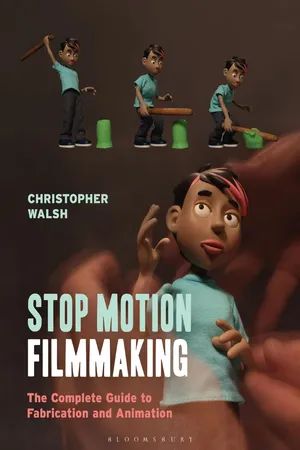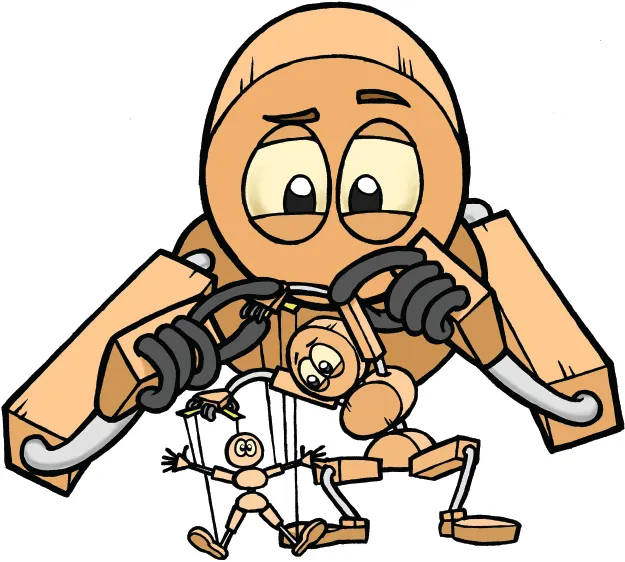
- 400 pages
- English
- ePUB (mobile friendly)
- Available on iOS & Android
eBook - ePub
About this book
Based on a world-class curriculum and cutting-edge industry practices, Stop Motion Filmmaking offers step-by-step instruction in everything from puppet making and studio set-up to animation and filmmaking. Reflecting exciting advancements in the medium, animator and educator Christopher Walsh focuses closely on digital filmmaking techniques, and offers specific instruction for creating 3D designed and printed puppet components as well as hand-crafted elements. The book is enriched by exclusive online content in the form of detailed tutorials and examples, and by dynamic sidebars and inserts.
Further accented by interviews with leading professionals from both the independent and major studio worlds, Stop Motion Filmmaking is designed for dedicated students of the art form, and provides invaluable training for any serious artist who is driven to bring frame-by-frame worlds to life through puppet animation.
Further accented by interviews with leading professionals from both the independent and major studio worlds, Stop Motion Filmmaking is designed for dedicated students of the art form, and provides invaluable training for any serious artist who is driven to bring frame-by-frame worlds to life through puppet animation.
Frequently asked questions
Yes, you can cancel anytime from the Subscription tab in your account settings on the Perlego website. Your subscription will stay active until the end of your current billing period. Learn how to cancel your subscription.
No, books cannot be downloaded as external files, such as PDFs, for use outside of Perlego. However, you can download books within the Perlego app for offline reading on mobile or tablet. Learn more here.
Perlego offers two plans: Essential and Complete
- Essential is ideal for learners and professionals who enjoy exploring a wide range of subjects. Access the Essential Library with 800,000+ trusted titles and best-sellers across business, personal growth, and the humanities. Includes unlimited reading time and Standard Read Aloud voice.
- Complete: Perfect for advanced learners and researchers needing full, unrestricted access. Unlock 1.4M+ books across hundreds of subjects, including academic and specialized titles. The Complete Plan also includes advanced features like Premium Read Aloud and Research Assistant.
We are an online textbook subscription service, where you can get access to an entire online library for less than the price of a single book per month. With over 1 million books across 1000+ topics, we’ve got you covered! Learn more here.
Look out for the read-aloud symbol on your next book to see if you can listen to it. The read-aloud tool reads text aloud for you, highlighting the text as it is being read. You can pause it, speed it up and slow it down. Learn more here.
Yes! You can use the Perlego app on both iOS or Android devices to read anytime, anywhere — even offline. Perfect for commutes or when you’re on the go.
Please note we cannot support devices running on iOS 13 and Android 7 or earlier. Learn more about using the app.
Please note we cannot support devices running on iOS 13 and Android 7 or earlier. Learn more about using the app.
Yes, you can access Stop Motion Filmmaking by Christopher Walsh in PDF and/or ePUB format, as well as other popular books in Media & Performing Arts & Film & Video. We have over one million books available in our catalogue for you to explore.
Information
Part one
Puppet fabrication
Part 1 of this book is entirely dedicated to puppet fabrication. As a quick glance at the Table of Contents will reveal, it's an extremely detailed section that provides you with very specific and practical instructions for the construction of a professional puppet from start to finish. Part of the reason for this level of detail is that it's a pretty complex process, but that's not the only reason this book examines puppets in such detail.
From the earliest examples of stop motion, through to the work that's being created today, a common thread that connects it all is a desire to record the trials and tribulations, the joys and the sorrows, of these miniature creatures. Many are small-scale representations of ourselves – perhaps exaggerated or distorted for dramatic or comedic effect, but human, nonetheless.
Their forms vary greatly, along with the actions they perform and the stories they tell. But whether they're made from humble pieces of wood and wire, or space-age rubber and stainless steel, stop motion puppets are almost always expressions of the human experience.
1
An introduction to stop motion puppets
In the end we’re dependent on the creatures we’ve created.
Mephistopheles (Faustus II, Goethe)
In this chapter, we’ll begin the process of making puppets by first attempting to understand puppets better, both in general terms, and from a stop motion perspective specifically. Why bother with these more abstract notions instead of just jumping right into making things? Just as you’d take the time to get to know a living dancer, actor, or musician that you hope to create a performance with, you owe it to the puppet that you will eventually create to first understand its world a bit more thoroughly. With this better understanding, you’ll be in a better place to create a better puppet, and in time, a better performance through that same puppet.
By the end of this chapter, you’ll have a stronger understanding of the remarkable world of puppets, and a firmer foundation upon which you’ll be able to start fabricating your own miniature performance partner. You’ll also get to meet the puppet that you’re going to create, but I won’t ruin the surprise. I’ll let you read this chapter, first!

Figure 1.1
Midsummer Night’s Dream, Jiří Trnka, 1959.
A tender moment between puppets, in this beautiful production by the Czech master.
An introduction to puppets
Just by sitting on a shelf, a doll is doing what it’s meant to do. That is, it’s representing something else – a person, an animal, or a character of some sort. By contrast, a puppet may sit obediently on the same shelf alongside that doll, but it carries with it the expectation that it will be brought to life (or given life, depending on how you look at it). There’s an insistence that surrounds a puppet. It’s not fulfilled until it lives, even if that life is maintained, influenced, and ultimately controlled by, human hands. That’s not to say that a doll can’t have artificial life given to it. Who else attends the tea parties of little kids worldwide, if not ‘living’ teddy bears and dolls? But a doll doesn’t need to be alive. A puppet does.
What can we say about this life that puppets acquire? Well for one thing, it’s not true, biological life. It’s pretended life. But rather than making things less interesting because it lacks a pulse, the opposite becomes true about the lives of puppets. This false life is capable of achieving remarkable things. Just look at Kermit the Frog! Yet it’s all the result of the actions and words of a character that is only temporarily (and occasionally) alive. It’s not that dissimilar to our own lives, really. We are born, we live, and then, inevitably, we pass away. When you consider things this way, it’s easy to appreciate how existentially significant puppets are to an understanding of the human experience.

Figure 1.2
Zimbo, Juan Jose Medina and Rita Basulto, 2015.
The story of a marionette that longs to cut his strings. Cast in the role of the marionette? A stop motion puppet. A beautifully existential short film.
Complicating things further is the fact that the artificial life of a puppet is so deeply connected to the puppeteer or animator. When you make a puppet, and later perform through it, an amazingly complex relationship is formed. It can be a bit like a parent/child relationship – after all, the artist has given life to the puppet, as a parent does a child. It brings to mind poor Geppetto from Pinocchio, as he constantly frets and chases after his wooden child. The boy may be fake, but the emotions felt by the old carpenter are very real.
Yet this deep emotional attachment can also be broken very easily. All the puppeteer or animator has to do is place the puppet back on its shelf. Now it’s just an object again – at least until it’s time to perform once more. How can a relationship be so emotionally real, and at the same time, so imagined? How can it be so ‘on’, then so ‘off’? You may have asked yourself this same question about a relationship you’ve had with a real person! Once again, we can learn a lot about ourselves through our work with puppets.
An overview of puppets
Of course, our medium doesn’t claim ownership over puppets. They’ve been around for thousands of years in one form or another, and all of these types of puppets continue to be used today. Some have been modified over the years by technological and artistic innovations, but most remain unchanged at a basic level. Regardless of style, they all provide artists with a way to make statements about humanity and the world in which we live.

Here’s Roy, animating Roy, as he puppeteers Roy. Don’t think about it too much, or your brain will explode.
Shadow puppets
The requirements for this form of puppetry are basic: a flat puppet, a strong light source, and a surface upon which to cast the puppet’s shadow. The shadow puppet’s origins may pre-date recorded human history, coming as it does from a time of fire and cave walls. Eventually, a screen would replace the wall, providing both a separation from the audience and a fantastic canvas for the puppeteer to tell the story. Movement of the puppet between the light source and the screen encourages changes in size and quality of the shadows, allowi...
Table of contents
- Cover
- Title Page
- Dedication
- Contents
- Introduction
- Part one: Puppet fabrication
- Part two: The studio
- Part three: Animation
- Part four: Making a film
- Further reading
- Index
- Acknowledgements
- eCopyright